Broad-spectrum antibacterial, strong antibacterial activity, low drug resistance, analgesic, antipruritic, promote healing
Highly safety
Introduction
Generic Name: Triple Antibiotic Ointment
Active Ingredients: This product is a compound preparation. Each gram contains Bacitracin 500 units, Neomycin sulfate 3500 units, Polymyxin B sulfate 5000 units and Lidocaine hydrochloride 40mg.
Description: This product is a pale yellow ointment with a petroleum jelly odor.
Uses: This medication is used to prevent and treat minor skin infections caused by small cuts, scrapes, or burns.
Dosage and administration: This medication is for use on the skin only. Clean and dry the affected skin area. If you are using the ointment, wash your hands first. Then apply a small amount of medication (no more than can fit on your finger tip) in a thin layer on the skin and rub in gently, usually 2 to 4 times a day. Do not use this product for longer than 1 week unless directed by your doctor.
Adverse reactions: Rash (including redness, burning), itching/swelling may occur occasionally.
Contraindications: Not for use in patients who are sensitive to any of the ingredients used in the ointment.
Precautions:
1. Avoid use in large areas of burns, granulation tissue or large areas of skin wounds;;
2. When the patient has renal dysfunction or systemic application of other nephrotoxic or ototoxic drugs, the possibility of toxicity should be noted.
3. Hematuria, decreased urination, decreased or increased urine output, and nephrotoxicity such as tinnitus and ototoxicity and loss of vision should be used with caution.
4. Avoid getting this medication in eyes or inside the nose or mouth. If this occurs, wipe off the medication and rinse thoroughly with water.
5. Pregnant women, lactating women and children under two years of age need to follow the doctor's advice.
Medicine interaction: This ointment is rarely absorbed in the body with a small area of skin topical application, therefore, it does not cause interaction problem with other drugs.
Unit Packing: 3 g/5 g/10 g/15 g packed in laminated tube + individual box.
Expire Date: 36 months
Fonow——Formulated classic topical antibacterial
The topical formulation has been used effectively for the prevention and treatment of common skin infections since 1953. It has been applied in the European and American countries for more than sixty years.
Fonow is certificated in FDA and authorized for selling in North America.
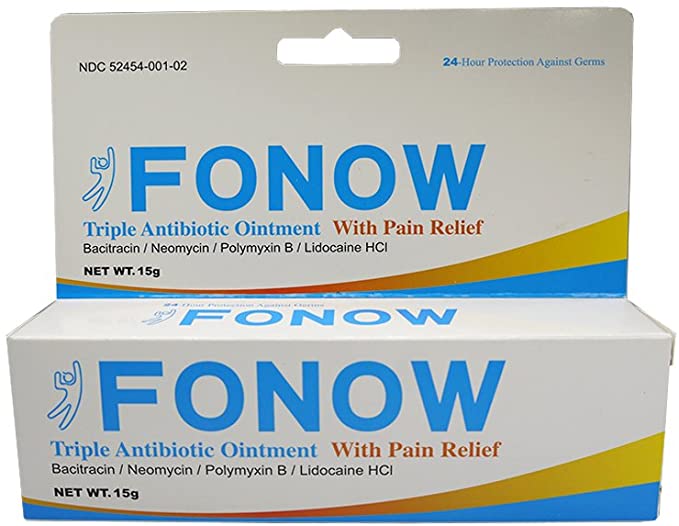
Fonow——The mechanism of Triple antibiotics
Bacitracin
Inhibits the dephosphorylation of C55-isoprenyl pyrophosphate, a biphosphate lipid transport molecule essential, for the synthesis of the peptidoglycan bacterial cell wall.
Polymyxin B
Exhibits its antibacterial effects by increasing bacterial cell wall permeability, a process that disrupts osmolar integrity and contributes to cell lysis.
Neomycin
Inhibits protein synthesis by binding to the bacterial 30S ribosomal subunit and interfering with mRNA translation.
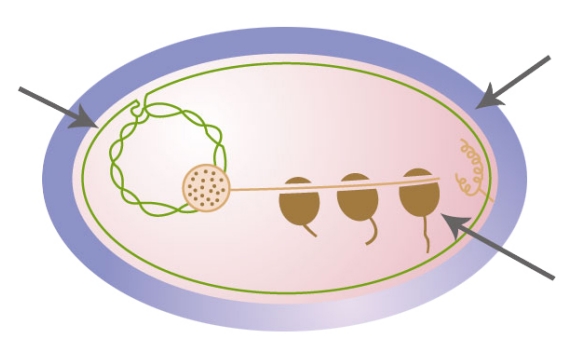
Fonow——The mechanism of Lidocaine
Analgesic: Inhibition of nerve impulse conduction, block the transmission path of nociceptive stimuli.
Antipruritic: Suppress the connection between the C-nerve fibers of the nervous system and mast cells.
Anti-inflammatory: Lidocaine can reduce the inflammatory mediator synthesis and release, interfere with inflammatory cascade reaction and other effects.
Fonow——The mechanism of Petrolatum
Help restore skin barrier function, reducing TEWL by 99%.

Petrolatum applied to the skin surface can form a protective film, so that the skin is not susceptible to perspiration, urine and other mechanical stimulation
FONOW Properties
Widely antibacterial spectrum, Strong antibacterial activity, less resistance
Analgesic, Antipruritic, Promote healing
Highly safety
Widely antibacterial spectrum—Against Gram-positive Bacteria and Gram-negative Bacteria
Polymyxin B Sulfate: Disrupt the bacterial cell membrane, has bactericidal action against Acinetobacter baumannii, Escherichia coli, Pseudomonas aeruginosa etc.
Neomycin Sulfate: Inhibit bacterial protein synthesis, has good activity against Staphylococcus aureus, Escherichia coli, Bacillus proteus, Klebsiella pneumonia etc.
Bacitracin: Disrupt the Bacterial cell wall, has bactericidal action against Streptococcus pyogenes, Streptococcus pneumoniae, Staphylococcus aureus, Propionibacterium acnes etc.
Strong antibacterial activity—topical effective concentration is much higher than the minimum inhibitory concentration(MIC).
Suppose there is 100 μl of water locally, with 1g acting on the skin or wound.
Strong antibacterial activity—Synergistic
The antibacterial effect of the the three combined antibiotics is much greater than the effect of any of the antibiotics use only.
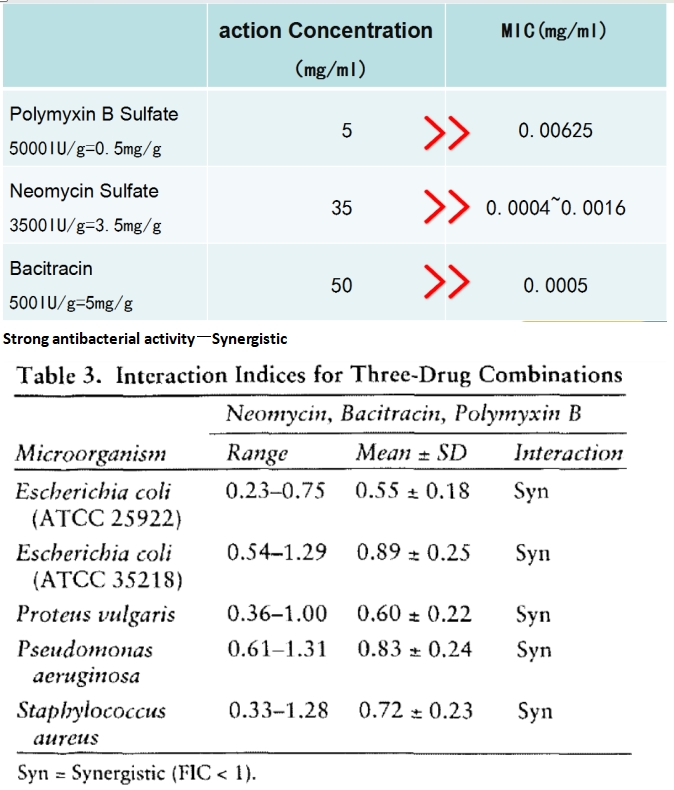
Less Resistance
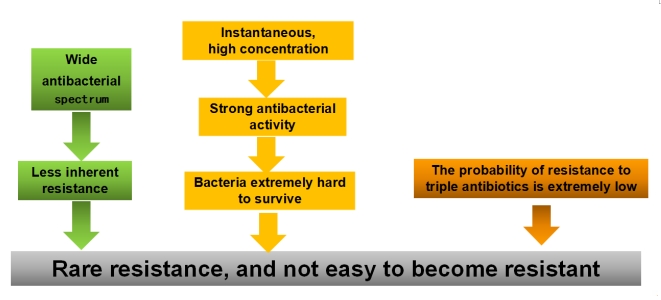
At a 1:100 dilution of the ointment concentration, TAO inhibited all CoNS, Pseudomonas aeruginosa, and Enterobacteriaceae isolates, and resistance to TAO among Staphylococcus aureus at this concentration was only 5% in the cross-resistance study.
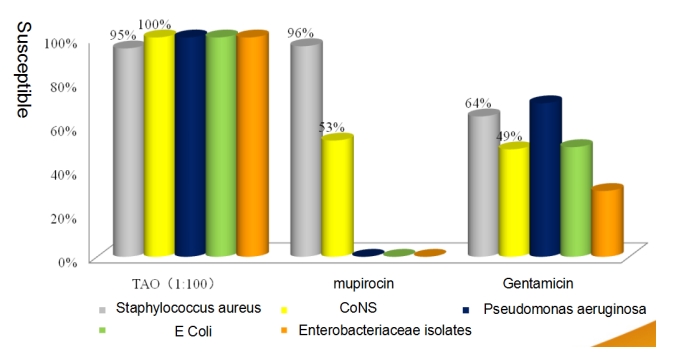
The result distribution by year (1997–2002) for topical antimicrobial agents against 159 isolates of S. aureus nonsusceptible to gentamicin.
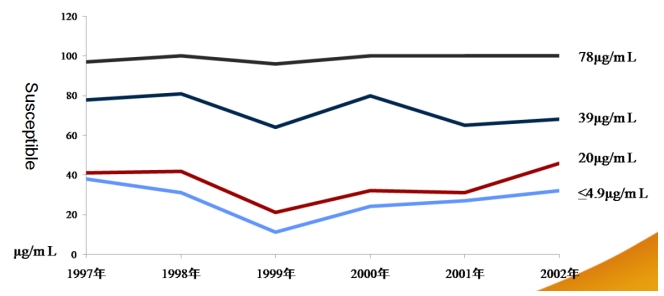
Fonow——Analgesic, Antipruritic, Promote healing
Analgesic
Thirty patients with a total of 60 burn wounds on the trunk or extremities were randomized. The self-control study showed that the pain score of compound polymyxin B ointment (3.4 ± 1.45) was significantly lower than that of silver sulfadiazine (4.6 ± 1.68) (P <0.001).
Antipruritic
Chronic pruritus guidelines indicate that topical lidocaine can relieve pruritus in the short term.
Anti-inflammatory
Lidocaine can reduce the inflammatory media synthesis and release, interfere with the role of inflammatory cascade reaction, to achieve anti-inflammatory effect.
It has been reported that lidocaine inhibits the proliferation of PMBC induced by SEA and SEB, Inhibit immune activation.
Lidocaine acts by expressing FoXP3 in regulatory T cells (Tregs) Immunosuppressive effect. At the same time, lidocaine improved TH1/TH2 cells and Imbalance between IL-17A / IL-17E cytokines.
Promote healing
In a randomized, open-label, human clinical model study, triple antibiotic ointment treated blisters with Staphylococcus aureus-infected wounds at a much faster rate of wound healing (averaging 9 days) than other drug-treated wounds
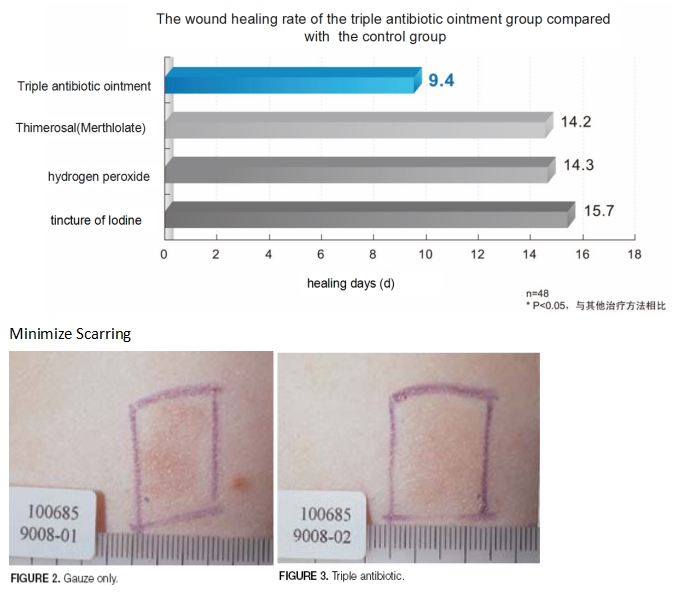
At 90 days, the triple-antibiotic ointments had a statistically significantly lower mean score than that of gauze only (P< 0.001).
Highly safety
Rate transdermal absorption
Rabbit skin area of about 5 × 10 square centimeters of external damage, use 2g triple antibiotic ointment, serum antibiotic concentrations did not get the detection limit.

Studies have shown that: the adverse reaction rate of Fonow external using is low.